NAFTA by Commodity and By State in 2016
TOPICS
Wheat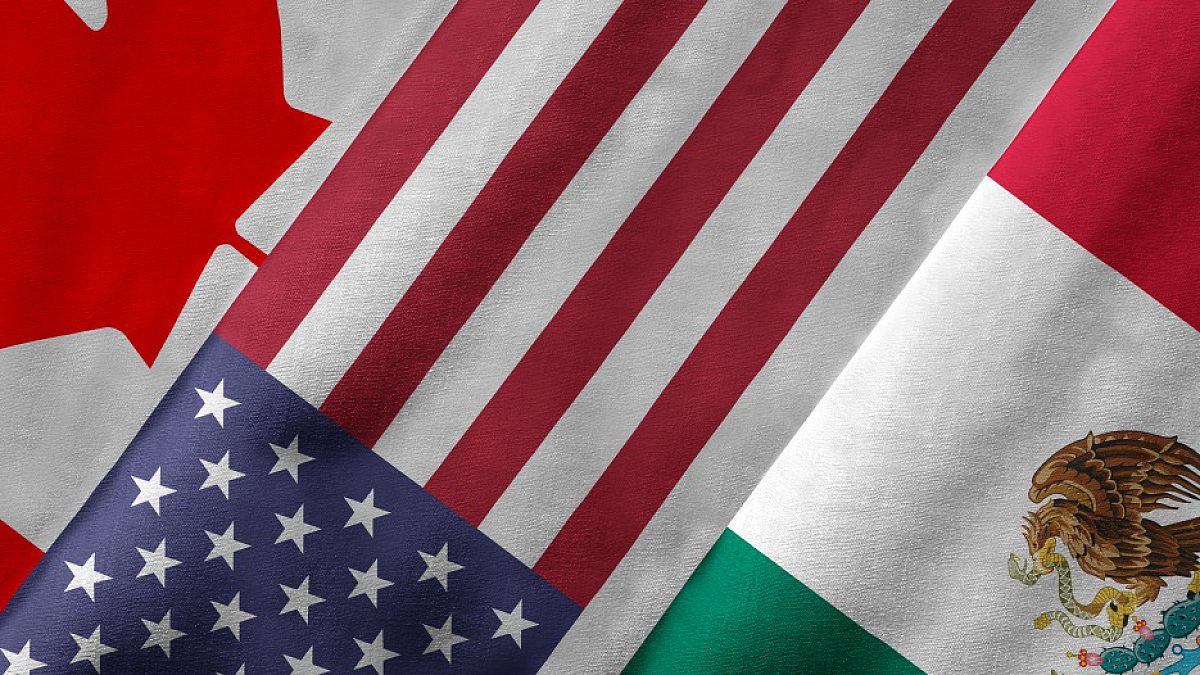
photo credit: iStockPhoto
John Newton, Ph.D.
Chief Economist
Note: Analysis reflects USDA-published U.S. Census Foreign Trade Division agricultural trade data, and may not be the point of origin for agricultural commodities.
Whether farmers are raising cattle in Oklahoma, milking cows in Vermont, growing fruits and vegetables in Florida, or growing corn, soybeans and wheat in America's heartland, their agricultural income depends on trade. USDA estimates that 25 percent of all U.S. agricultural production is exported, and for some commodities that percentage is even higher.
Many of these trade benefits come on the back of the North American Free Trade Agreement, which has helped to increase U.S. agricultural exports by more than 200 percent since 1993. Today’s article builds on recent Farm Bureau analyses of NAFTA by reviewing the share of agricultural exports to NAFTA partners by state and by commodity.
Share of Exports by State and Commodity
Reviewing the share of agricultural exports to NAFTA partners by state and by commodity provides additional perspective on the value of NAFTA to each state. The commodities reviewed in today’s article include corn, soybeans, wheat, rice, fruits and vegetables, dairy, livestock and poultry. It’s important to note that this data reflects U.S. Census Foreign Trade Division agricultural trade data, and may not be the point of origin for agricultural commodities. For more on the limitations of state export data visit USDA's help page.
Corn
NAFTA: Feed Grains reviewed the benefits of NAFTA to U.S. exports of corn and feed grain products. For many years Mexico has been one of the top export markets for U.S.-produced corn. During 2016, $9.9 billion of U.S. corn was exported to 72 countries in global markets. Of this total, $2.5 billion was shipped to Mexico and $146 million was shipped to Canada. Combined, Mexico and Canada represented 27 percent of U.S. corn exports in 2016. As identified in Figure 1, in portions of the Upper Midwest and Western Corn Belt, 60 to 100 percent of corn exports were received by our NAFTA partners in 2016.
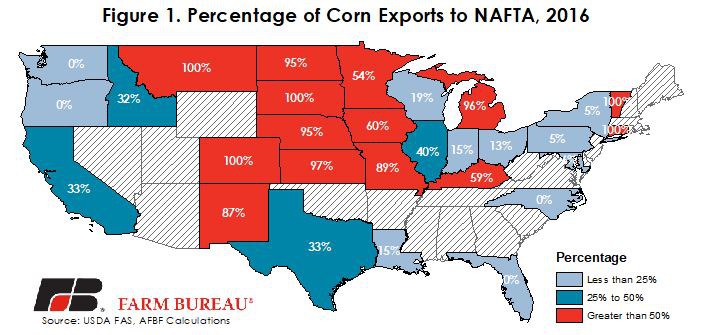
Soybeans
Most of the soybeans exported from the U.S. are destined for China, with one-third of every soybean acre harvested in the U.S exported to China. The second largest market for U.S. soybeans is Mexico. During 2016, $23 billion of U.S. soybeans were exported to 62 countries in global markets. Of this total, $1.5 billion was shipped to Mexico and $106 million was shipped to Canada. Combined, Mexico and Canada represented 7 percent of U.S. soybean exports in 2016. While in total soybean exports to NAFTA countries are dwarfed by China, as identified in Figure 2, in portions of the Western Corn Belt a majority of soybean exports were received by Canada or Mexico in 2016.
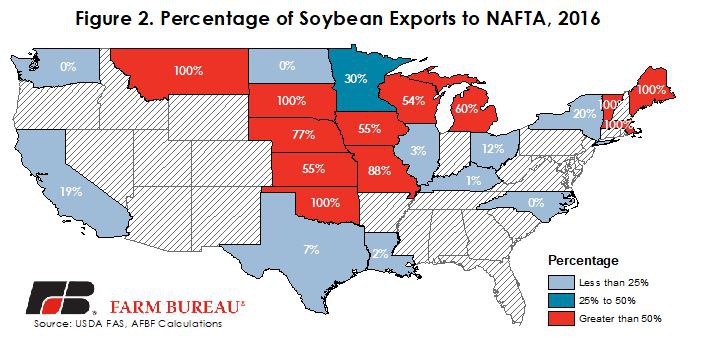
Wheat
NAFTA Holds Mexico’s Door Open to U.S. Wheat; Could Open Cross-Border Trade with Canada highlighted the benefits of NAFTA to U.S. exports of wheat. During 2016, $5.4 billion of U.S. wheat was exported to 62 counties in global markets. The top export market was Mexico followed by Japan. Of total wheat exports, $611 million was shipped to Mexico and $18 million was shipped to Canada. Combined Mexico and Canada represented 12 percent of U.S. wheat exports in 2016. Wheat exports to NAFTA countries were the highest in eastern portions of the Pacific Northwest and Central Plains, Figure 3.
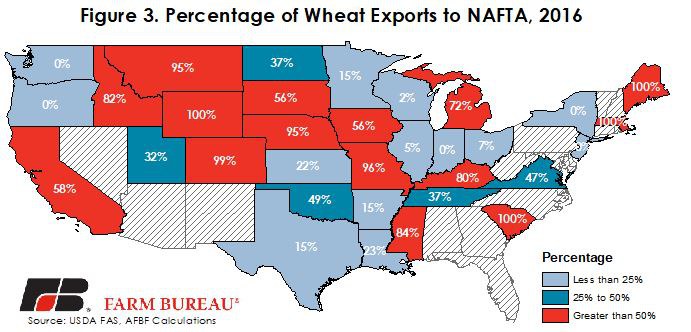
Rice
U.S. Rice and NAFTA reviewed the benefits of NAFTA to U.S. rice exports. During 2016, $1.8 billion of U.S. rice was exported to 124 counties in global markets. Like wheat, the top two export markets were Mexico and Japan, while Canada was fourth. Of total rice exports, $274 million was shipped to Mexico and $148 million was shipped to Canada. Combined Mexico and Canada represented nearly 24 percent of U.S. rice exports in 2016. Figure 4 highlights the percentage of rice exports by state to our NAFTA partners.
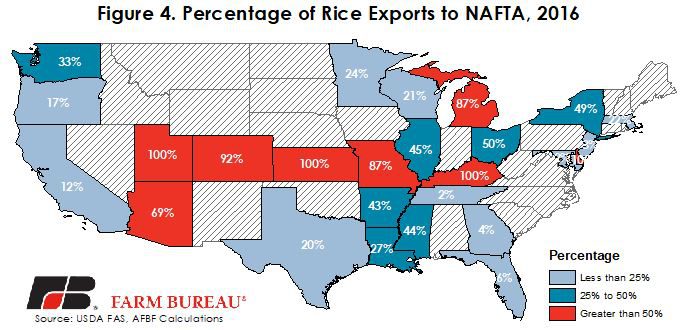
Fruits and Vegetables
Several articles on Market Intel reviewed the importance of NAFTA to fruit and vegetable trade including, Fruits of the NAFTA Vine, NAFTA: Veggie Tales, and U.S. Apples and NAFTA. Hundreds of countries around the world received U.S.-produced fresh and processed fruits and vegetables, totaling more than $11.3 billion. Whether it’s fresh or processed, Mexico and Canada are among the top three export markets for these products. During 2016, Canada received $4.5 billion of U.S.-produced fruit and vegetable products and Mexico received $1 billion. Combined they represented nearly 50 percent of all U.S. fruit and vegetable exports. Figure 5 highlights the share by state, and of the lower 48 states, more than half of the states exported more than 50 percent of these products to NAFTA partners.
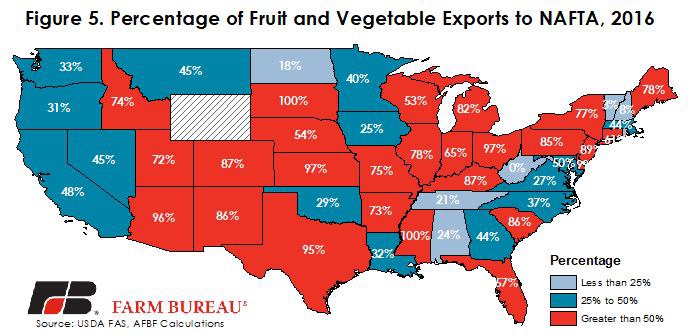
Dairy
U.S. access to the Canadian dairy market was not a part of NAFTA. Nevertheless, the Canadian dairy industry is a key component of the NAFTA 2.0 conversation (i.e. Canadian supply management and new milk pricing provisions). Market Intel has reviewed these issues in depth, U.S. Dairy and NAFTA and Canada Closes Door on U.S. Dairy Farmers. As such, mending NAFTA is incredibly important to the U.S. dairy industry.
During 2016, $4.7 billion in U.S. dairy products were shipped to Mexico and Canada, two of the top three dairy export markets. Of total dairy exports, $1.2 billion was shipped to Mexico and $631 million was shipped to Canada. Combined Mexico and Canada represented nearly 40 percent of U.S. dairy product exports in 2016. Figure 6 highlights the percentage of dairy product exports by state to our NAFTA partners.
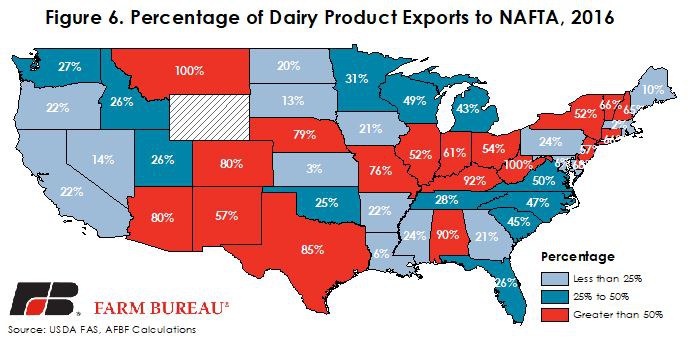
Livestock and Meats
When the trade in livestock is considered, the first commodities that come to mind are beef and pork. However, the ability to move live animals across borders is part of the larger meat and livestock supply chain in North America. Live animal exports totaled $697 million during 2016, and the top two export markets were Canada and Mexico, each receiving approximately $129 million in live animal products. Combined, nearly 40 percent of live animal exports including horses, fowl, cattle, swine and live poultry were exported to our NAFTA partners. The integrated North American market is dependent on the ability to transport live animals across borders. Figure 7 highlights the dependence on live animal exports by state.
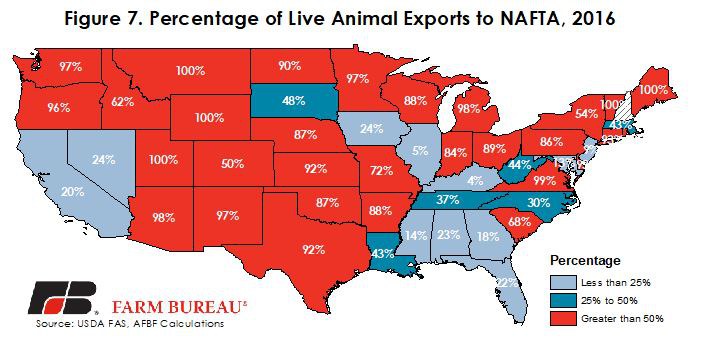
NAFTA: Where’s the Beef? and NAFTA & The Three Little Pigs reviewed the importance of NAFTA to meat exports. Beef and veal exports totaled $5.4 billion during 2016: Mexico was the third largest market and Canada the fifth largest market, importing more than $1.3 billion of products from the U.S. Combined, 24 percent of U.S. beef and veal exports are delivered to Canada and Mexico. Figure 8 identifies the share of beef exports to NAFTA countries by state.
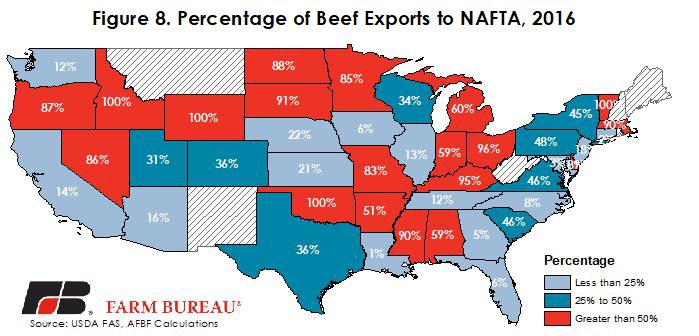
During 2016, $4.9 billion of pork products were exported from the U.S. Japan is the largest export market followed by Mexico and Canada. Combined, Mexico and Canada imported $1.9 billion of U.S. pork products, representing nearly 40 percent of all U.S. pork exports. Figure 9 identifies the share of pork exports to NAFTA countries by state.
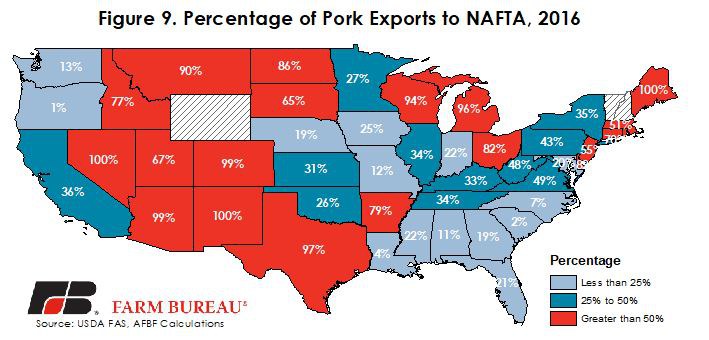
Poultry
Just Clucky: NAFTA Poultry Trade reviewed the importance of NAFTA to poultry trade. During 2016, poultry and poultry product exports, including meat and eggs, totaled $4.7 billion. Mexico and Canada are the top two export markets for U.S. poultry, importing $1.1 billion and $663 million, respectively. Combined, NAFTA partners represented 39 percent of all poultry exports in 2016. Figure 9 identifies the share of poultry product exports to NAFTA countries by state.
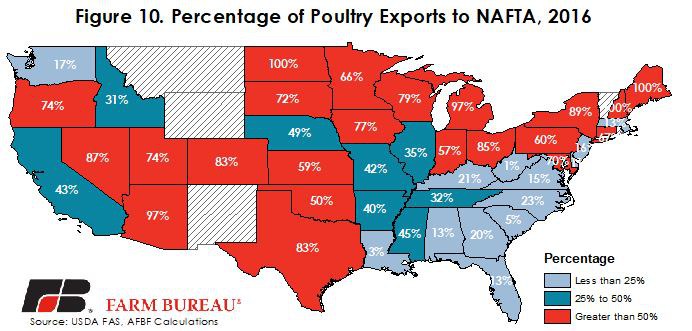
Summary
To help inform Farm Bureau members on the importance of NAFTA during the NAFTA 2.0 negotiations more than 15 articles detailing the importance of NAFTA to different agricultural sectors, from apples to vegetables, have been published on American Farm Bureau Federation’s Market Intel. These analyses are identified throughout this article and are bookended by Revisiting NAFTA: The Way it Could Be and Importance of NAFTA to Agriculture in Each State for 2016. Other articles highlighting the benefits of NAFTA to food manufacturing and alcoholic beverages are also available in NAFTA: U.S. Food and Non-Alcoholic Beverage Manufacturing and NAFTA: No U.S. Barley, No (Mexican) Beer.
As negotiations continue in the coming months, it is important for farmers and ranchers to remain engaged and to share the importance of trade to the farm economy. As evidenced in today’s analysis, and in all NAFTA-related Market Intel articles, agriculture in every state and across a broad range of commodities depend on NAFTA.
